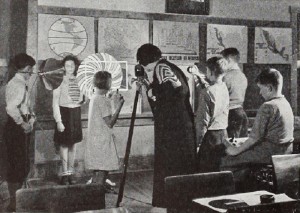
"Mrs. Anne Filut of Milwaukee, possibly entered the most ambitious undertaking to be viewed by the judges. Eleven reels of 8mm film on 'Creative Work in Fractions,' in which she clearly shows the principles of her subject and the fundamentals of the work she is teaching, taken in the class room with the children themselves as the actors. She was given honorable mention." American Cinematographer, Feb. 1936, 73.
"Curt is the story of a blind college student and the world in which he must live. Although he puts on a brave front, his problems exist and he must take them in stride. Dennis Thomas, who produced the film, brings his character to the audience, breathing life into him so effectively than long after the film is through one has a feeling for Curt and his world. The black-and-white photography is excellent throughout and the pacing shows an excellent knowledge of the mechanics of editing. This film well deserves the Student Film Award it received" PSA Journal, Sept. 1964, 50.
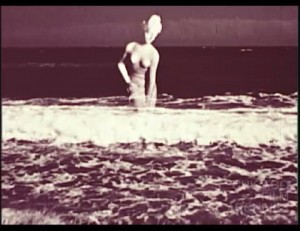
"A short travelogue film on the Republic of Cyprus. A narrator warmly introduces viewers to the charms, history and people of Cyprus." Chicago Film Archives.
"Design, by Walter Mills, ACL, is an expository film study on 8mm. and shows to fine advantages the possibilities of this medium for serious cinematic undertakings. In this 200 foot reel, the story of a day at the Kendall Art School, in Grand Rapids, Mich., has been told coherently and instructively. The picture represents real skill in planning, selection of viewpoint and photography. Naturally, most of the sequences in the film called for interior shots and the maker is to be commended highly for his lighting arrangements, which give perfectly normal effects in the film without the usual glare and unevenness. Angle shots and unusual camera positions are used with restraint but with most happy results when the situation calls for them. The technical quality is of uniform excellence and the cutting is done with particular care." Movie Makers, Dec. 1933, 522.
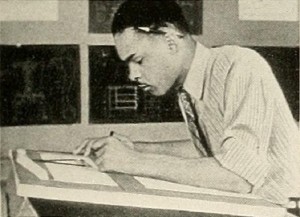
"Education for Life, an attractively filmed record of the daily work of the Hampton Institute, famous school for Negro youth, was produced by the Harmon Foundation and filmed by Mr. and Mrs. Ray Garner. The well planned sequences of this picture tell, in detail, of the high lights of the school's activities. The Garners were faced with the problem of recording, in color, a wide variety of skin tones and with the problem of lighting large areas. These problems were solved with more than the usual skill, and they have turned out an almost perfect filming job. They exercised an excellent choice of camera angles, and the whole film is a thoroughly polished production. The amount of detail in a picture of this type is considerable, but the subject matter is well balanced. The introductory material, a series of ''zoom" shots of maps, is especially well done." Movie Makers, Dec. 1941, 568.
"Adequate illumination of the large areas of classrooms, auditoriums and laboratories, each with varied light absorbing or reflecting characteristics, presents a respectable problem to the average movie maker, even with the dual aid of supersensitive film and Photofloods. However, in Emma Willard School, T. W. Willard, ACL, has met and overcome this problem with great success and moreover with attractive and satisfying results. Although the production of the film would appear to have been beset with a whole range of large scale lighting problems, from balancing the daylight from large window areas to illuminating rooms completely with artificial light, not once are the results cramped in any way. Important action is highlighted to feature it and there is always a pleasant composition of illumination." Movie Makers, Dec. 1934, 546.
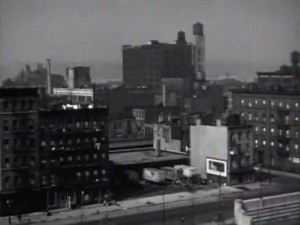
"Barstow created this depiction of the Hudson Guild, a community center in Manhattan's Chelsea District, while a "Boys' Group Worker" at the Hudson Guild Neighborhood House." Via Vimeo upload.
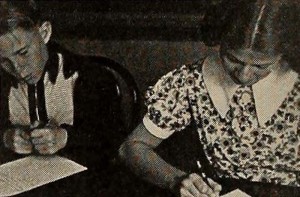
"First Film and When the Cat's Away, a double header entry, which takes honors jointly because of the strong relationship between the two, is the production of the Cinema Club of Lowell Junior High School, at Long Beach. Calif., and of the club's faculty adviser, Helen Rees Clifford. First Film, largely the work of Miss Clifford, summarizes the Junior High School group's experiences in producing When the Cat's Away, which is entirely the achievement of the youngsters. Together, the two films present a clear and concise picture of the initial production of a film by a junior high school movie club, from scenario writing and movie planning to the completed opus, ready for its premiere. So, in these two reels, one sees how the job of teaching movie making technique to youngsters, of ages from eleven to fourteen, can be handled efficiently and happily, and one learns how clear and coherent a little picture can be produced as a starter. Few high school photoplay clubs have begun so well and with so little lost motion. Very few high school first films are as clear and competent as When the Cat's Away." Movie Makers, Dec. 1938, 618.
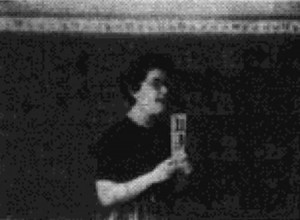
"A community service in filming the activities of the George E. Slye School in East Hartford, Conn. We start with the young boys and girls on the playground, their orderly return to the classrooms. Then we visit the first and second grades to observe the teaching and learning methods. There is a lunch room, a dispensary, and an audio hearing test center. All learn to sing, blending their young voices in the classroom. Those who have the interest, are taught to use musical instruments and an appreciation of the drama. Physical education for good health is as important as Parent-Teachers organization meetings Focus on Slye is a truly fine community service" PSA Journal, Oct. 1962, 35.
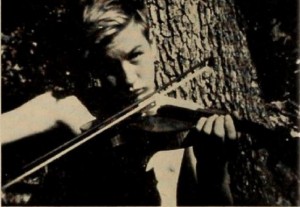
"The familiar plight of a boy who disappears just before his music lesson is the simple springboard launching The Great Man Hunt. The subsequent adventures of the older brother and a reluctant pal who search for the errant youngster build into a chase sequence (on the teen age level) that is soundly representative of basic movie techniques. In developing this theme, Donald Volkman set himself many a difficult exposure problem — notably in shots of the boys aboard a trolley car and in wooded areas with sunlight slanting through tall trees. His solution of these problems is satisfying in every case. Further, Mr. Volkman's cross cutting in the chase sequences indicates intelligent study of professional masters of this technique. A swift climax is presented amusingly as the music teacher apprehends the boy who, wearing only a pair of swimming trunks, tucks a violin under his chin and proceeds to play his lesson at the edge of a lake." Movie Makers, Dec. 1949, 455.
Total Pages: 5